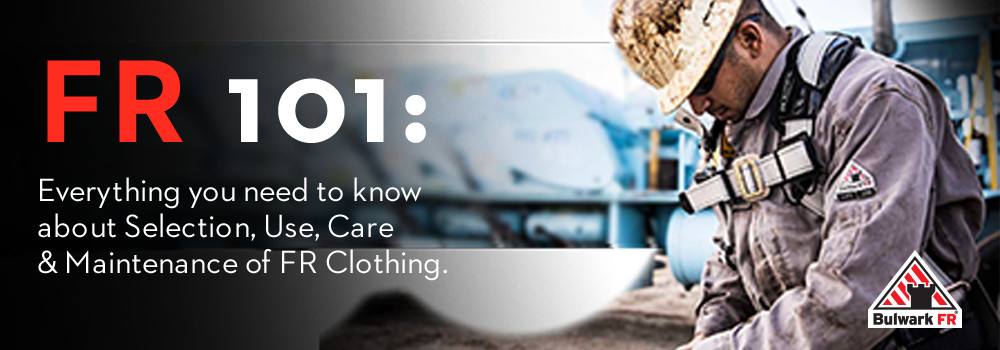
SPONSORED
FR 101: Selection, Use, Care & Maintenance
Overview
Flame Resistant (FR) clothing is a required part of PPE programs across a wide range of industries. Proper selection, use, care and maintenance of FR clothing is essential to ensuring the safety of workers, and it is ultimately up to employers and safety managers to identify, select, and provide the proper clothing for their workers.
Hazard Risk Assessment
The first thing employers must do to protect workers is determine whether workplace conditions could present a threat, by conducting a Hazard Risk Assessment.
In the Oil & Gas Industry, flash fire is the primary hazard. The NFPA® defines flash fire as “a fire that spreads by means of a flame front rapidly through a diffuse fuel, such as dust, gas, or the vapors of an ignitable liquid, without the production of damaging pressure.”
Selection
When selecting FR clothing, employers should refer to industry consensus standards for guidance. The industry consensus standards for flash fire are NFPA® 2112 and NFPA® 2113.
NFPA® 2112, “Standard on Flame-Resistant Garment for Protection of Industrial Personnel Against Flash Fire,” covers the performance and material standards to which FR garments must comply. This includes everything from fabric capabilities and characteristics to garment construction. This standard applies more to manufacturers of FR fabrics and garments than to safety professionals or end-users of FR clothing.
NFPA 2113, “Standard on Selection, Care, Use, and Maintenance of Flame-Resistant Garments for the Protection of Industrial Personnel Against Flash Fire,” is the companion standard to NFPA 2112, and it is the “go-to” standard that employers, safety managers, and individual wearers should consider when selecting the correct garment.
Using FR Correctly
Even the best PPE program cannot effectively protect a worker if it is used improperly. Employers should be certain that any program begins with proper training and is accompanied by an ongoing policy that ensures workers are caring for and using their PPE properly.
NFPA® 2113 states, “The basis of this training should, as a minimum, be the user information provided by the manufacturer of the flame-resistant garment.” However, it does not stop there; the standard goes on to require that manufacturers provide extensive user information including safety considerations, use limitations, garment marking recommendations and restrictions, warranty information, maintenance and cleaning procedures and more.
For the Oil and Gas industry, there are some universal rules that should be followed when wearing FR garments. These rules include some “common sense” practices such as tucking in shirts, rolling down sleeves, keeping garments zipped or buttoned up, and ensuring coveralls are worn properly.
Additionally, there are less obvious rules around garments worn under FR; non-FR undergarments are permitted if they are made from non-melting fabrics like cotton, silk, or wool. However, the use of an FR base layer is a great way for wearers to increase their overall protection level. The small amounts of elastic used in socks and underwear are the only meltable fibers allowed.
Care and Maintenance
Proper care and maintenance of FR clothing is another important element of any effective program. There are a few basic things to consider:
First, a garment may be stained, but still be perfectly safe to wear. On the other hand, a garment may look clean but may still smell like fuel. Any odor of secondary accelerants indicates the presence of a potentially combustible substance. In this case, the garment must be rewashed until the odor is no longer present.
Second, washing with bleach or peroxide will harm flame-resistant fabrics; don’t use these laundry products alone or as additives to detergent.
Last, any kind of buildup on the surface of the garment fibers can be dangerous. Avoid treatments and additives, such as starch, fabric softener, and DEET-based insect repellant.
Follow these simple tips when laundering your FR:
- Do not use bleaches or peroxides
- Do not use any additives, such as fabric softeners or starch, that could build up to impede FR performance
- Avoid washing in hard water
- Wash FR garments separately from other garments
- Wash FR garments inside out to improve color-retention and preserve appearance
- Use liquid detergent for best results
- Avoid extreme washing and drying temperatures to reduce shrinkage
- Soak garments in liquid detergent or non-bleach, non-peroxide pre-wash stain removers to address tough stains
- Dry clean garments with stubborn stains
- Tumble dry on low settings and never over-dry
- Rewash any garments with lingering odor
If FR clothing is damaged, it may be repaired using flame resistant fabric and thread, as long as the garment’s flame resistant integrity is maintained. It is recommended to retire any FR garment with a hole larger than a quarter or a rip greater than 3” in length.
Conclusion
Industry consensus standards and best practices can help organizations achieve compliance with the regulations surrounding PPE, but ultimately, the responsibility rests on employers. When it comes to selection and use, it is critical that they choose the PPE appropriate to the task, train their employees in proper use, care and maintenance, and implement an ongoing policy that ensures workers are using PPE efficiently and effectively to maximize safety.
Bulwark is the undisputed leader in FR, with over 45 years of frontline experience. For more information on the proper selection, use, care and maintenance of FR, get in touch with a Bulwark expert: bulwark.com/contact